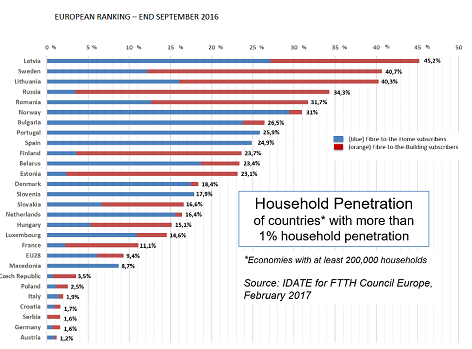FTTH CONFERENCE 2017, MARSEILLE – The number of fibre to the home (FTTH) and fibre to the building (FTTB) subscribers in Europe increased by 23 per cent over the first nine months of 2016, reaching nearly 44.3 million, according to the latest update to the FTTH rankings unveiled today by the FTTH Council Europe and its research partner Idate.
A closer look at the data shows huge variations from country to country, with a few large nations dominating. Idate’s research includes 39 countries in continental Europe, including Russia, which alone counts for 17 million of those subscribers. Between them, Europe’s 28 member states (EU28) had 20.5 million FTTH/B subscribers at the end of September 2016.
Aside from Russia, the largest FTTH/B markets in absolute figures are Spain, which saw 72 per cent growth to reach 4.5 million subscribers and France, which increased 32 per cent to reach 3.2 million subscribers. Spain also recorded the highest increase in homes passed: up by 34 per cent.
As the host country of the conference, France’s situation was widely discussed. Roll-out and adoption of fibre networks is growing steadily in France. The “Plan France Très Haut Débit” seeks to bring very high-speed broadband service, mainly based on fibre infrastructure, to every home, business and government office by 2022. Local authorities – who are allowed to act as a wholesale operators – are accelerating FTTH rollouts in rural and suburban areas, with the aim of bridging the digital divide. As a result, France’s penetration rate gained almost three points, from 8.5 per cent the year before, to 11.1 per cent at end-September 2016.
In terms of position in the ranking, Lithuania lost its crown to Latvia, which now holds the number one spot in Europe, with a penetration rate of 45.2 per cent in September 2016. Sweden increased its penetration rate to 40.7 per cent, boosting the country to second place, while Lithuania saw an increase to 40.3 per cent, up from 36.8 per cent a year ago, earning it the third position.
Two new countries passed the one per cent adoption threshold to join the FTTH Ranking this year: Austria and Serbia. In fact, it’s more instructive to examine which countries are still missing: the UK is the only major economy still not represented (Germany joined the FTTH ranking last year).
“The latest European FTTH ranking proves what we have believed at the FTTH Council Europe for the past year: looking at countries such as France and Spain, and the overall FTTH growth rate in Europe, it is now clear that there is a stronger than ever momentum towards FTTH,” said Ronan Kelly, president of the FTTH Council Europe. “We are glad to witness such progress, including two new countries entering our FTTH ranking. We feel that Europe is now well positioned to stimulate even more FTTH rollout: the European Commission’s recent Gigabit Society Communication sets a vision where widespread, very high capacity networks underpin the services to society that will keep Europe at the forefront of economic development.”
Even countries that have traditionally spurned fibre, instead favouring upgraded copper technologies, are now evolving into a more fibre-friendly environment, he notes. In Ireland, the Government’s National Broadband Plan changed its network specification to require FTTH-based infrastructure, while the UK government has now allocated a fund specifically dedicated to FTTH deployment. Many more similar initiatives are expected in the coming months. Nearly all players, even those that are less involved in FTTH/B, now consider that FTTH is the end game, according to the FTTH Council Europe.


